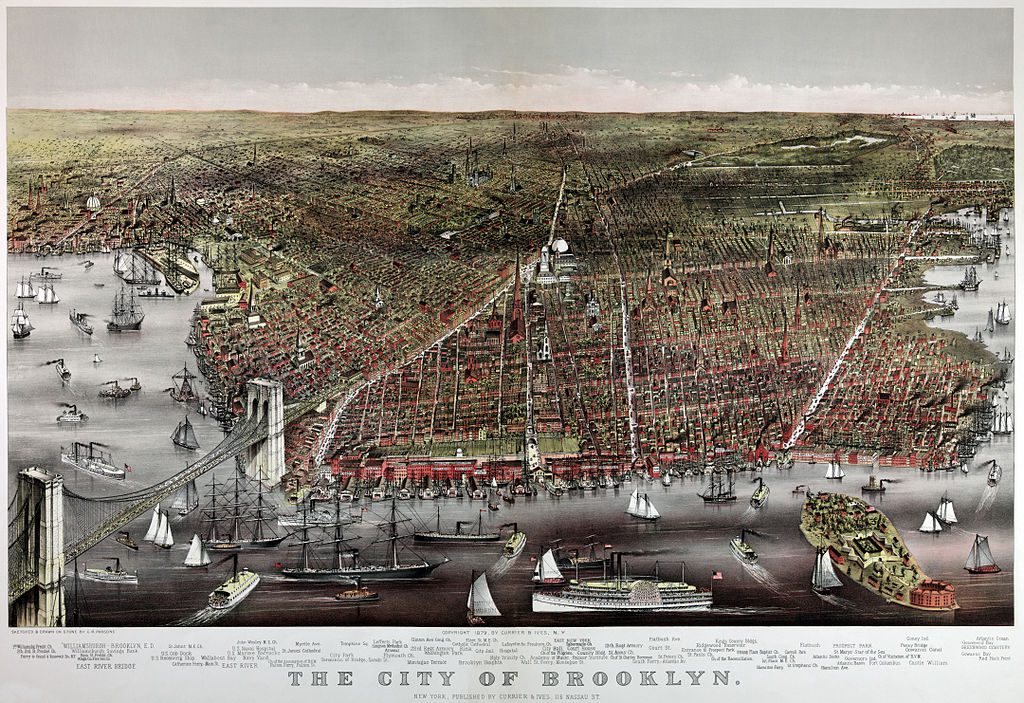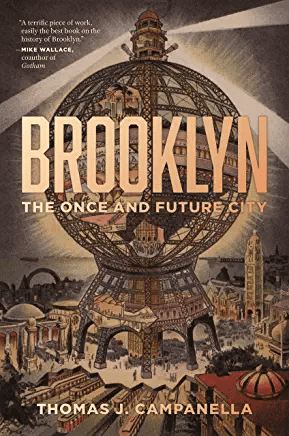The Lost History of the ‘City’ of Brooklyn

Brooklyn: The Once and Future City, Thomas Campanella, Princeton University Press, 550 pages.
Cornell Professor Thomas Campanella’s new book is not only the best history of Brooklyn, it’s one of the most entertaining works published this year, suffuse with fantastic tales of the achievements, iniquities, and dreams of its famous neighbor. “Brooklyn may be a brand known around the world, but it is also terra incognita,” Campanella writes, “a terrain long lost in the thermonuclear glow of Manhattan, possibly the most navel-gazed city in the world outside of Rome and the subject of dozens of good books.”

In the 1897 referendum that merged the city into the five boroughs of Greater New York, Brooklyn just barely assented to its subaltern status—passing there by a paltry 277 votes. To this point it had competed very capably with its fancier neighbor across the river, but its official assumption by the city seemed to only accentuate Brooklyn’s wilder and more outlandish tendencies. So with Manhattan inheriting the crown, Brooklyn turned to the traditionally wilder tracks of younger sons. “Conditional proximity, for lack of a better term, made Brooklyn a displacement zone of sorts, a site for peoples and practices untenable in the heart of town—suspect religions, racial outcasts, citizen non-conformists, and later, dirty industrial operations and morally polluting amusements.”
Campanella’s book doesn’t presume to be comprehensive history, but its episodic chapters will leave you with many more facts about Brooklyn than you currently possess, and add more texture to familiar urban geography than first meets the eye.
In one early example, Brooklyn contains Gravesend, a colonial 17th-century community founded by Deborah Moody, a New England Anabaptist expelled from Massachusetts but welcomed to New Netherland—sort of. She was granted some land in then-distant Long Island, where she founded an early master-planned community, an enclave of religious toleration whose street grid still vestigially girds Southern Brooklyn. Relics of the Battle of Brooklyn, the largest naval operation since the Spanish Armada and one of the largest battles of the 18th-century American Revolution, similarly lurk amidst the borough’s 19th-century landmark Brownstone townhouses.
Speaking of that symbol of Brownstone Brooklyn, its excellent physical assets are a bit more familiar, but ably told here by Campanella. Today’s borough still benefits from the then-independent city’s determination to outdo Manhattan’s Central Park in hiring Frederick Law Olmsted, who produced a larger and finer park in Brooklyn. Prospect Park emerged a masterpiece but is only part of the story, with Olmsted creating linked boulevard projects of the Coney Island and Eastern Parkways (and the partially-executed Shore Road Parkway).
***
For all its achievements, Brooklyn’s ambitions have often been larger than its means, and the book is replete with grand schemes only partially executed or not at all. A monumental plaza at the convergence of the Brooklyn and Manhattan Bridges is unfortunately the stuff of fantasy, as was a proposal for a gargantuan marine park, planned for 1,840 acres (larger than both Central and Prospect Parks combined). Typically modest and affordable ideas included a two-mile formal canal, on a site that consisted mainly of marshland. Naturally this wasn’t built, but the bulkhead line of the grand harbor remains visible at low tide.
Just nearby was the site of another planned 1914 boondoggle, “one of the most heroically misguided infrastructure projects ever proposed,” which was creating a shipping harbor in Jamaica Bay. Observing the insufficiency of usable shipping space both in Manhattan and in Brooklyn along New York Harbor, city dreamers looked to the seemingly capacious bay, in which they hoped to build one of the largest harbors on earth. That wasn’t all; the plan involved a canal across Queens to the Long Island Sound. There were a few ways to do this, none of them easy. One would have required multiple locks in order to traverse a height of 100 feet above sea level; the other was a “canal tunnel.” In any case, the project would have had to accommodate a three-hour difference in tidal timing between the sound and the ocean, which entailed six-foot differences in their height.
There was still another catch. All of these plans attracted acclaim without considering the fact that Jamaica Bay is catastrophically ill-suited for use as a harbor, as it’s mainly shallow and full of shifting sand not far beneath its surface. This was hardly news. As Campanella writes, “Revolutionary-era charts with soundings for all New York Harbor and the Hudson and East rivers give none for Jamaica Bay—damning evidence indeed of its lack of suitability for maritime use.”
Not far away, other less grand infrastructure plans flourished. Grand resort hotels sat near to racetracks (the largest of which, Sheepshead Bay, was the most profitable in the country in 1905), and fabled amusement parks such as Luna Park and Dreamland make any Coney Island-style contemporary entertainment look tame. These pleasure grounds were all buttressed by a foundation of truly titanic graft and corruption—one man, John Y. McKane, was Gravesend town constable, commissioner of common lands, chief of police, as well as president of the Town Board, Board of Health, Police Board, and Water Board for much of the 1870s and 1880s. His Caligulan rule didn’t terminate in jail for well over two decades, but did increase the stock of local saloons to over 700. “His administration was also responsible for turning a once-lovely place for a family outing into an unholy warren of gambling dens, whorehouses….”
 Pleasure island did not lack for Pinnochios, of course. Perhaps the most entertaining—and shocking— story in the book is that of a “steampunk orb” slated for Coney Island’s Steeplechase Park. The brainchild of St. Louis swindler-fantasist Samuel Friede, it was a globe-shaped tower slated to contain an “Aerial Hippodrome,” “continuous four-ring circus,” “aerial palm garden,” ballroom, cafe, and weather observatory. It was to stand 700 feet high and 900 feet wide, accessed by 10 elevators.
Pleasure island did not lack for Pinnochios, of course. Perhaps the most entertaining—and shocking— story in the book is that of a “steampunk orb” slated for Coney Island’s Steeplechase Park. The brainchild of St. Louis swindler-fantasist Samuel Friede, it was a globe-shaped tower slated to contain an “Aerial Hippodrome,” “continuous four-ring circus,” “aerial palm garden,” ballroom, cafe, and weather observatory. It was to stand 700 feet high and 900 feet wide, accessed by 10 elevators.
It’s probably no surprise that there were disputes between the builder and the park’s owner—or that the head of finances for the tower was embezzling as many dollars as he could pocket. Or that the foundation for the tower was sunk considerably short of the depth necessary to support its projected height. This is all familiar to those now-seasoned observers of fraud, but others might raise an additional eyebrow. The Globe Tower Company’s vice president, one Edward A. Langan, also happened to be the chief inspector of elevators for the Brooklyn Bureau of Buildings. This monumental conflict of interest wasn’t enough to result in any serious threat to his position until a few more details emerged of his civic practices:
“The truth also came out about Langan’s uncanny knack for selling Globe Tower stock. He simply forced applicants for building bureau permits or approvals to buy a cartload of Globe Tower stock before he would sign off on anything.”
A series of laws severely restricting racetrack gambling took effect in 1908, largely due to New York Governor Charles Evans Hughes (most notable for losing the presidency to Woodrow Wilson in 1916). He cleared the Augean stables but hobbled the rest of this entertainment district, and the lame remnants were taken out and shot in stages. By September 1910 all racetracks had closed, and Coney Island’s three principal grand hotels shuttered in 1911, 1916, and 1924. Some other amusements persisted, such as the wooden-tracked Sheepshead Bay Motor Speedway, but the golden age was over, for better or worse.
A few miles away in Jamaica Bay (and in the path of misbegotten harbor schemes) was one of the most revolting places in the metropolitan area. In the city’s rendering works on the appropriately named Barren Island was a destination for the unlucky horse, dog, fish, and occasionally larger circus animal. This fragrant location boiled down countless animals and their waste, processing 1.8 million pounds of dung at its peak. Campanella notes drolly that there was no trash collection on this island, a basically lawless place that emitted vile scents for miles (along with all of its grisly effluent draining into Jamaica Bay) and was the focus of several campaigns until it finally closed in 1920.
Barren Island then became the site of one of New York’s first modern airports, the quite advanced Floyd Bennett Field, which languished with unpopular commercial flights from the start for a forgotten reason: the early importance of airmail to profitability, which was routed through the more convenient Newark Airport.
And there’s still much more: the repeat misfortunes of the postwar period, which involved massive job and population loss along with the flight of the fabled Dodgers baseball team, closure of the Brooklyn Eagle newspaper and many other core institutions, all coupled with especially destructive highway and urban renewal projects. “No city would suffer more in the name of urban renewal than New York, and nowhere was the devastation greater than Brooklyn.” Even if the smelly rendering works was long closed, Brooklyn was a dumping ground for undesirable features—alternately neglected and mangled with thoughtless plans, as New York concentrated attractions and employment in its imperial center of Manhattan, leaving the borough to wither.
Yet that’s no longer the case. Brooklyn has turned a corner, with neighborhoods that rival the cost of almost any in Manhattan; today, Brooklyn t-shirts sell briskly around the world. It now also at last has a book worthy of itself—this one.
Anthony Paletta has contributed to The Wall Street Journal, The Weekly Standard, The Guardian, and numerous other publications. He lives in Brooklyn.
Comments